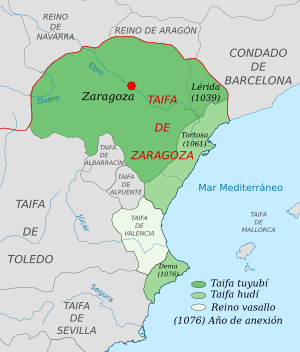Taifa of Lérida facts for kids
The Taifa of Lérida was a small Muslim kingdom in what is now Spain. It existed between 1039 and 1102. A "Taifa" was a small state that formed after the big Caliphate of Córdoba broke apart. Lérida (also known as Lleida) was its main city. Sometimes, Lérida was an independent kingdom. Other times, it was part of the larger Taifa of Zaragoza, ruled by a governor.
Contents
How Lérida Became a Taifa
Lérida was first ruled by governors from the Banū Tudjīb family. In 1039, a ruler named al-Mustaʿīn from the Banū Hūd family took control of Lérida and Zaragoza. Before he died in 1046, al-Mustaʿīn put his younger son, Yūsuf, in charge of Lérida. His older son, Aḥmad al-Muḳtadir, took over Zaragoza in 1046.
From 1045, the Christian Count Ramon Berenguer I of Barcelona made these brothers pay him money. This payment, called parias, was to stop him from attacking their lands. In 1064, the brothers had a disagreement. This happened after they lost the city of Barbastro to a Christian army. Al-Muḳtadir blamed Yūsuf for this defeat. However, they soon got Barbastro back.
Lérida's Changing Rulers
Al-Muḳtadir of Zaragoza grew his kingdom. He took the Taifa of Tortosa in 1061. Then, he added the Taifa of Denia in 1076. He and his brother Yūsuf fought a war between 1078 and 1081. In the end, al-Muḳtadir reunited all the lands his father had ruled.
When al-Muḳtadir died in 1081, his kingdom was split between his two sons. His younger son, al-Mundhir, received Lérida. He was already governing Denia and Tortosa for his father.
Facing Christian Kingdoms
The Taifa of Lérida was in the northeast. This meant it was often attacked by Christian kingdoms. Sancho Ramírez, the king of Aragon, and his son, Peter, pushed their armies down the Cinca valley. In 1083, they captured the city of Graus.
Between 1087 and 1093, King Peter took more cities. These included Estada, Monzón, and Almenar. In 1089, Count Ermengol IV of Urgell also attacked towards Balaguer. He might have even taken the city for a short time.
The End of the Taifa
In 1090, al-Mundhir died. His son, Sulaymān ibn Hūd, became ruler, but he was still a child. His regents (people who ruled for him) divided the kingdom. They separated Denia and Tortosa for themselves. Sulaymān was left with only Lérida.
In 1100, Peter, now king of Aragon, captured Barbastro. This was the second most important city in Lérida's kingdom. He also took Sariñena. By 1101, the Aragonese had captured Pomar de Cinca and Albalate de Cinca. This brought them right up to Lérida itself.
Under al-Mundhir and his son, Lérida paid tribute to Christian counts. These included Count Ramon Berenguer III of Barcelona and Count Ermengol V of Urgell. Ermengol V died in 1102 while fighting the Almoravids. These were North African Muslim fighters trying to take over Lérida. Lérida likely fell to the Almoravids that same year. Some say it lasted until 1110. The Almoravids appointed governors to rule Lérida. Finally, Christian forces captured the city in 1149.
Rulers of Lérida
- Yūsuf ibn Sulaymān ibn Hūd al-Muẓaffar (1039/1046–1078/1081)
- al-Mundhir al-ḥādjib (1081–1090)
- Sulaymān ibn Hūd (1090–1102/1110)
See also
 In Spanish: Taifa de Lérida para niños
In Spanish: Taifa de Lérida para niños


